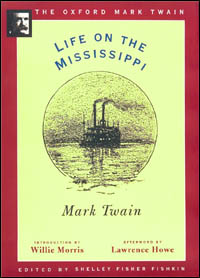
 |
...and yet, superhuman as the steamboat pilot's comprehensive knowledge of every aspect of the Mississippi River seems, one of the great things about Life on the Mississippi is that it's easy to relate to, moreso now than in the 19th century. After all, Twain's really talking about, well, driving, and the Mississippi was his road. Mine are currently I-91 and MA-116, with a little MA-9 and US-5 thrown in now and then. If you have a car and a job, you probably have a commute of your own. And don't you know your roads well enough to make that trip on autopilot? It doesn't even have to be travel: learning to play the guitar, or mastering the interface of Europa Universalis II, or teaching a course... at first every chord, every menu, every manual page is a mountain to surmount, but eventually the instrument or program or book becomes an extension of yourself and you can navigate through it without conscious thought. Same with the steamboat pilots and their river. This section is terrific stuff.
The second half isn't quite so good — it's yet another travelogue, as twenty-one years after lighting out for the territories, Twain returns to the Mississippi and takes a trip on what in 1882, after the railroads have come in, is a relic of a vanished era: the steamboat. Along the way, he writes it up in his usual manner: with witty reporting mixed with short stories, newspaper articles, anything that popped into his head. The highlight of this portion is Twain's return to his boyhood home of Hannibal, Missouri... his account of the uncanny mix of familiarity and strangeness that accompanies returning to a place you've lived is certainly something I can relate to, having lived in and subsequently returned to various spots across the country. What I wouldn't give to be able to go back to Anaheim Hills for a day — specifically, for a day in 1984 or so. Back when it was still freshly carved out of the foothills, before everything had been bulldozed to put in more and more tightly-packed housing, back when the sidewalks meandered through the brush-covered hills, back when all the architecture came in shades of brown, wooden letters over storefronts in all the early-80s fonts... when I've gone back with Jennifer it's been different enough that I haven't really been able to show her where I grew up. But it comes with the territory: the defining characteristic of life is transience, and you can't step in the same river twice.
